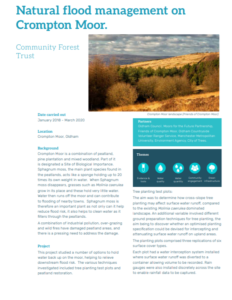News release from the Environment Agency
Innovative flood risk management techniques have taken another step forward on Crompton Moor in Oldham with the installation of five “leaky dams”. In a project funded by the Environment Agency and the EU LIFE IP Natural Course programme and delivered by City of Trees in partnership with Oldham Council, The Unity Partnership (LLFA) and the Friends of Crompton Moor, the dams form just one part of the mosaic of measures being trialled on site to test how nature based solutions can reduce risk of flooding.
Leaky dams are natural structures constructed from tree trunks installed across a watercourse to slow the flow of water in a river. They are able to hold back significant volumes of water when it rains and then slowly release the water over a much longer period of time compared to a free flowing river. This has the benefit of reducing the ‘peak’ flow of water thereby reducing flood risk to communities downstream.
David Brown, Flood Risk Senior Adviser for the Environment Agency said: “Working with natural processes is an important part of managing and reducing flood risk in a sustainable way. This pilot project on Crompton Moor will not only slow the flow of flood water and create habitat for wildlife but will help demonstrate the potential of such schemes for climate mitigation.
“Natural flood management can make a vital contribution to the restoration of our green spaces and our flood resilience across Greater Manchester. We continue to be extremely grateful to our partners, volunteers and the local community who are helping to deliver these important schemes. It’s a numbers game though, and we need many, many more of these types of projects to make a real difference to the flood risk downstream. ”
Pete Stringer, Technical & Green Infrastructure Planning Manager at City of Trees said: “This project demonstrates that through routine thinning works in woodlands we have a source of material that can be used to reduce the risk of flooding to local communities. This is yet another example of why trees are such a crucial resource in improving our resilience to climate change.”
The Natural Flood Management project forms part of the Environment Agency’s overall vision to develop flood management schemes that will not only reduce the risks to local communities, but also tackle climate change through carbon capture and new habitats for wildlife. More information can be found in the EA’s Flood and Coastal Risk Strategy: https://www.gov.uk/government/publications/national-flood-and-coastal-erosion-risk-management-strategy-for-england–2
Click here to view the Natural Course case study
